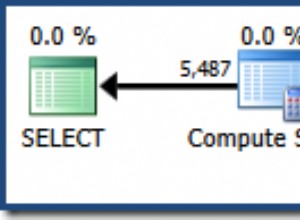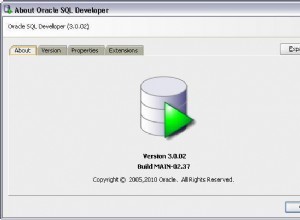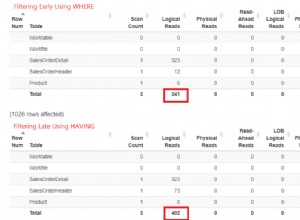डेटा का चयन करने के लिए इसे आजमाएं:
with xyz as (
select tech_type,
connect_by_root(link_id) as root_link_id,
connect_by_root(group_id) as root_group_id
from tech_values
start with parent_group_id = 0
connect by prior group_id = parent_group_id
)
select root_link_id, root_group_id,
a_tech_type as tech_type_a, b_tech_type as tech_type_b, c_tech_type as tech_type_c
from xyz pivot (
count(1) as tech_type
for tech_type in (
'A' as A,
'B' as B,
'C' as C
))
;
39000 रिकॉर्ड के एक परीक्षण सेट पर इसकी गणना करने के लिए Oracle 11.2 (और फ्लश बफर कैश) के साथ लगभग 0.15 सेकंड के साथ एक Intel Core i5 लिया। मुझे आशा है कि यह आपकी ज़रूरतों को पूरा करने के लिए पर्याप्त तेज़ है।
इन डेटा के साथ लक्ष्य तालिका को अपडेट करने के लिए, उपरोक्त के माध्यम से या तो लूप करें SELECT और अपने link_counts को अपडेट करें तालिका को पुनरावृत्त करें, या बस MERGE . का उपयोग करें कथन:
merge into link_counts T
using (
with xyz as (
select tech_type,
connect_by_root(link_id) as root_link_id,
connect_by_root(group_id) as root_group_id
from tech_values X
start with parent_group_id = 0
connect by prior group_id = parent_group_id
)
select *
from xyz pivot (
count(1) as tech_type
for tech_type in (
'A' as A,
'B' as B,
'C' as C
))
) S
on ( T.group_id = S.root_group_id )
when matched then
update
set T.tech_type_a = S.a_tech_type,
T.tech_type_b = S.b_tech_type,
T.tech_type_c = S.c_tech_type
when not matched then
insert (link_id, group_id, tech_type_a, tech_type_b, tech_type_c)
values (S.root_link_id, S.root_group_id, S.a_tech_type, S.b_tech_type, S.c_tech_type)
;
MERGE मानता है कि GROUP_ID link_counts . में प्राथमिक/अद्वितीय कुंजी है मेज़। tech_values . की वास्तविक परिभाषा मूल प्रश्न में तालिका इस धारणा का समर्थन करती है।
SQL*Plus में चलाए गए परीक्षण का स्पूल इस प्रकार है:
SQL>
SQL> select count(1)
2 from user_indexes
3 where table_name = 'TECH_VALUES'
4 ;
COUNT(1)
----------
0
SQL>
SQL> select count(1)
2 from user_constraints
3 where table_name = 'TECH_VALUES'
4 and constraint_type != 'C'
5 ;
COUNT(1)
----------
0
SQL>
SQL> alter system flush buffer_cache;
System altered.
SQL> alter system flush shared_pool;
System altered.
SQL>
SQL> select systimestamp from dual;
SYSTIMESTAMP
---------------------------------------------------------------------------
08.06.14 23:18:40,053000 +02:00
SQL>
SQL> select tech_type, count(1)
2 from tech_values
3 where parent_group_id != 0
4 group by rollup(tech_type);
T COUNT(1)
- ----------
A 20048
B 39984
C 19984
80016
SQL>
SQL> select systimestamp from dual;
SYSTIMESTAMP
---------------------------------------------------------------------------
08.06.14 23:18:40,144000 +02:00
SQL>
SQL> alter system flush buffer_cache;
System altered.
SQL> alter system flush shared_pool;
System altered.
SQL>
SQL> select systimestamp from dual;
SYSTIMESTAMP
---------------------------------------------------------------------------
08.06.14 23:18:40,246000 +02:00
SQL>
SQL> with xyz as (
2 select connect_by_root(link_id) as root_link_id, connect_by_root(group_id) as root_group_id, tech_type
3 from tech_values X
4 start with parent_group_id = 0
5 connect by prior group_id = parent_group_id
6 )
7 select *
8 from xyz pivot (
9 count(1) as tech_type
10 for tech_type in (
11 'A' as A,
12 'B' as B,
13 'C' as C
14 ));
ROOT_LINK_ID ROOT_GROUP_ID A_TECH_TYPE B_TECH_TYPE C_TECH_TYPE
---------------------------------------------------------------- ------------- ----------- ----------- -----------
LETTER_B 1800 3667 7482 3854
LETTER_B 200 3712 7583 3708
LETTER_C 300 6326 12450 6229
LETTER_A 100 6343 12469 6193
SQL>
SQL> select *
2 from table(dbms_xplan.display_cursor())
3 ;
PLAN_TABLE_OUTPUT
------------------------------------------------------------------------------------------------------------------------------------------------------------------------------------------------------------------------------------------------------------------------------------------------------------
SQL_ID 59hmrtw6q3f4u, child number 0
-------------------------------------
with xyz as ( select connect_by_root(link_id) as root_link_id,
connect_by_root(group_id) as root_group_id, tech_type from
tech_values X start with parent_group_id = 0 connect by prior
group_id = parent_group_id ) select * from xyz pivot ( count(1)
as tech_type for tech_type in ( 'A' as A,
'B' as B, 'C' as C ))
Plan hash value: 3833790953
-------------------------------------------------------------------------------------------
| Id | Operation | Name | Rows | Bytes | Cost (%CPU)| Time |
-------------------------------------------------------------------------------------------
| 0 | SELECT STATEMENT | | | | 563 (100)| |
| 1 | HASH GROUP BY PIVOT | | 29102 | 1420K| 563 (1)| 01:23:35 |
| 2 | VIEW | | 29102 | 1420K| 1044 (47)| 02:35:00 |
|* 3 | CONNECT BY WITH FILTERING| | | | | |
|* 4 | TABLE ACCESS FULL | TECH_VALUES | 4 | 84 | 187 (0)| 00:27:46 |
|* 5 | HASH JOIN | | 29098 | 966K| 375 (1)| 00:55:41 |
| 6 | CONNECT BY PUMP | | | | | |
| 7 | TABLE ACCESS FULL | TECH_VALUES | 80020 | 1641K| 187 (0)| 00:27:46 |
-------------------------------------------------------------------------------------------
Predicate Information (identified by operation id):
---------------------------------------------------
3 - access("PARENT_GROUP_ID"=PRIOR NULL)
4 - filter("PARENT_GROUP_ID"=0)
5 - access("connect$_by$_pump$_002"."prior group_id "="PARENT_GROUP_ID")
31 rows selected.
SQL>
SQL> select systimestamp from dual;
SYSTIMESTAMP
---------------------------------------------------------------------------
08.06.14 23:18:40,805000 +02:00
SQL>
SQL> spool off




